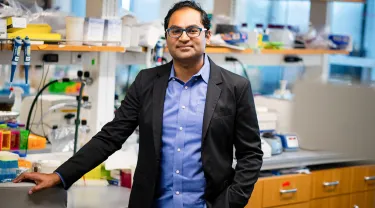Yeast is nature’s factory, feeding on sugars found in fruit and grains and other nutrients—producing alcohol for beverages and carbon dioxide to make bread rise.
Now, researchers at the School of Engineering have made modified yeast that can feed on a wider range of materials, many of which can be derived from agricultural by-products that we don’t use—leaves, husks, stems, even wood chips, things often referred to as “waste biomass.”
“If we can get yeast to feed on waste biomass, we can create a biosynthetic industry with a low carbon footprint,” said Nik Nair, associate professor of chemical and biological engineering.
Nair and his team decided to modify an existing genetic “dashboard” that yeast uses to regulate consumption of galactose, a sugar commonly found in dairy products.
The dashboard, called a regulon, includes genes for sensors that detect the presence of sugar and triggers enzymes for the chemical breakdown of sugar so its carbon and oxygen components can be rebuilt into new components. The new components are mostly small molecules and proteins that the yeast itself needs to survive, but they can also be novel products that scientists might have engineered into the yeast.
The researchers made minimal changes to the regulon, altering the sensor protein to accept multiple types of sugars, including xylose, arabinose, and cellobiose, all of which can be extracted from the indigestible woody parts of crops that are often tossed aside after harvesting.
About 1.3 billion tons of this waste biomass is produced each year, providing more than enough sugars to drive a vast industry of yeast biosynthesis.
Remodeling yeast to grow on waste biomass sugars sets the stage for improved production of biosynthesized products, which includes drugs such as insulin, human growth hormone, and antibodies. Yeast has also been engineered to produce vaccines, make drugs, create ethanol and other fuels, and even produce the building blocks of bioplastics, which can be used to make a variety of products.
These advances, Nair said, are allowing scientists to close a carbon cycle that has so far eluded the manufacturing of fuels, pharmaceuticals, and plastics.
